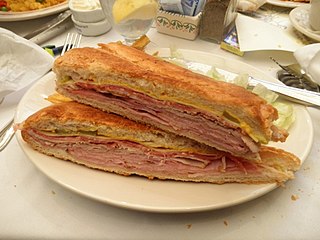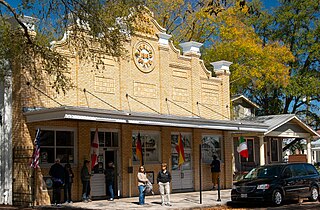
Tampa is a major city on the Gulf Coast of the U.S. state of Florida. The city's borders include the north shore of Tampa Bay and the east shore of Old Tampa Bay. Tampa is the largest city in the Tampa Bay area and the seat of Hillsborough County. With a population of 384,959 according to the 2020 census, Tampa is the third-most populated city in Florida after Jacksonville and Miami and is the 52nd most populated city in the United States.

A Cuban sandwich is a variation of a ham and cheese sandwich that likely originated in cafes catering to Cuban workers in Tampa or Key West, two early Cuban immigrant communities in Florida centered on the cigar industry. Later on, Cuban exiles and expatriates brought it to Miami, where it is also very popular. The sandwich is made with ham, (mojo) roasted pork, Swiss cheese, pickles, mustard, and sometimes salami on Cuban bread. Salami is included in Tampa, where there is a large Italian population, but is not usually included in South Florida.

Ybor City is a historic neighborhood just northeast of downtown Tampa, Florida, United States. It was founded in the 1880s by Vicente Martinez-Ybor and other cigar manufacturers and populated by thousands of immigrants, mainly from Cuba, Spain, and Italy. For the next 50 years, workers in Ybor City's cigar factories rolled hundreds of millions of cigars annually.
Tampa Heights is one of the oldest neighborhoods within the city limits of Tampa, situated in the central part of the city. As of the 2000 census, the neighborhood had a population of 16,393.
Palma Ceia is a neighborhood located southwest of downtown Tampa, Florida in South Tampa. It is bounded by Miguel Street West of MacDill Avenue and Neptune Street East of MacDill Avenue to the north; Bay to Bay Boulevard from Dale Mabry to Himes and El Prado between Himes and the Crosstown Expressway to the south; MacDill Avenue between Neptune and San Miguel, Dale Mabry Highway between San Miguel and Bay to Bay and Himes between Bay to Bay and El Prado to the west; and the Lee Roy Selmon Expressway to the east. The street names throughout Palma Ceia are of Cuban origin, coming from streets in the old section of Havana. Historians say the most likely explanation is that Angel Cuesta, president of Cuesta-Rey cigars, shared a map of Havana with developer Thomas Palmer while discussing the area.
The modern history of Tampa, Florida, can be traced to the founding of Fort Brooke at the mouth of the Hillsborough River in today's downtown in 1824, soon after the United States had taken possession of Florida from Spain. The outpost brought a small population of civilians to the area, and the town of Tampa was first incorporated in 1855.

Ybor City Museum State Park is a Florida State Park in Tampa, Florida's Ybor City. The museum occupies the former Ferlita Bakery building at 1818 9th Avenue in the Ybor City Historic District. The bakery was known for producing cuban bread and its ovens are part of the museum displays covering the history of the cigar industry and the Latin community from the 1880s through the 1930s. There is also an ornamental garden in the building.

The Ybor City Historic District is a U.S. National Historic Landmark District located in Tampa, Florida. The district is bounded by 6th Avenue, 13th Street, 10th Avenue and 22nd Street, East Broadway between 13th and 22nd Streets. Ybor City contains a total of 956 historic buildings, including an unparalleled collection of architecture with Spanish-Cuban influence, as well as historic cigar factory buildings and associated infrastructure. The area was developed by businessman Vicente Martinez Ybor beginning in 1886, and was for a time the world's leading supplier of cigars.

For the similarly named building in West Tampa see El Centro Español of West Tampa

The Centro Asturiano is a historic site in Ybor City, Tampa, Florida. It is located at 1913 Nebraska Avenue. On July 24, 1974, it was added to the U.S. National Register of Historic Places. It was designed by Tampa architect M. Leo Elliott.

The Ybor Factory Building is a historic site in Tampa, Florida, United States located at 1911 North 13th Street. The main factory and its surrounding support buildings cover an entire city block between 8th Avenue and 9th Avenues and 13th and 14th Streets in the Ybor City Historic District section of the Ybor City neighborhood. C. E. Parcell is credited as the building's architect.
V.M. Ybor is a neighborhood within the city limits of Tampa, Florida, United States. As of the 2010 census, the neighborhood had a population of 1,743. The ZIP Codes serving the neighborhood are 33602, 33603, and 33605.

Vicente Martinez Ybor, was a Spanish entrepreneur who first became a noted industrialist and cigar manufacturer in Cuba, then Key West, and finally Tampa, Florida.

Ybor City is a historic neighborhood that includes the Ybor City Historic District in Tampa, Florida. It is located just northeast of downtown Tampa and north of Port Tampa Bay. The neighborhood has distinct architectural, culinary, cultural, and historical legacy that reflects its multi-ethnic composition. It was unique in the American South as a prosperous manufacturing community built and populated almost entirely by immigrants.

Nicholas Chillura Nuccio was a two-time mayor of Tampa, Florida in the 1950s and 60s. He was the Tampa's first mayor of "Latin" descent, having been born and raised in the immigrant neighborhood of Ybor City.
Gary is an industrial section located in the southeastern part of Tampa, Florida, mainly in the vicinity of Adamo Drive east of Downtown Tampa.

The Tampa Smokers was a name used between 1919 and 1954 by a series of minor league baseball teams based in Tampa, Florida. The nickname was a nod to the local cigar industry, which was the most important industry in Tampa during the years in which the Smokers were active. During periods in which the name was not used by a professional team, various local semi-pro and amateur teams took up the Smokers name.

Gavino Gutierrez, a Spanish immigrant to the United States, was an importer, architect, civil engineer, and surveyor. He was responsible for bringing Vincente M. Ybor to Tampa, Florida and for designing Ybor City.

Anthony P. Pizzo (1912-1994) was a well-respected local historian and businessman, and was internationally recognized for his attempts to preserve the Italian American and Cuban American heritage and history of Tampa, Florida, and in particular that of his home neighborhood of Ybor City. From 1982 until his death in 1994, Pizzo was the official historian of Hillsborough County, and is author of several histories, most of which celebrate the unusual multicultural makeup of early Tampa. Pizzo also served as chairman of the Hillsborough County Historical Commission from 1968 to 1980, where he oversaw and was responsible for over eighty historical markers in Tampa and Ybor City.
Howard Avenue is a north-south road in the West Tampa and South Tampa sections of Tampa, Florida. South Howard is home to the SoHo (Tampa) entertainment district and several popular restaurants and bars. North Howard is home to several historic buildings.















